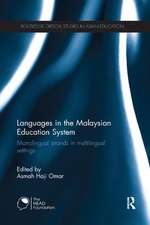Languages in Migratory Settings: Place, Politics, and Aesthetics
Editat de Alison Phipps, Rebecca Kayen Limba Engleză Paperback – 7 iun 2017
Preț: 216.07 lei
Preț vechi: 258.66 lei
-16% Nou
Puncte Express: 324
Preț estimativ în valută:
41.35€ • 43.28$ • 34.41£
41.35€ • 43.28$ • 34.41£
Carte tipărită la comandă
Livrare economică 31 martie-14 aprilie
Preluare comenzi: 021 569.72.76
Specificații
ISBN-13: 9781138084698
ISBN-10: 1138084697
Pagini: 144
Dimensiuni: 174 x 246 mm
Greutate: 0.45 kg
Ediția:1
Editura: Taylor & Francis
Colecția Routledge
Locul publicării:Oxford, United Kingdom
ISBN-10: 1138084697
Pagini: 144
Dimensiuni: 174 x 246 mm
Greutate: 0.45 kg
Ediția:1
Editura: Taylor & Francis
Colecția Routledge
Locul publicării:Oxford, United Kingdom
Public țintă
Postgraduate and UndergraduateCuprins
1. Introduction: Languages in migratory settings: place, politics and aesthetics 2. Divorce and dialogue: intertextuality in Amara Lakhous’ Divorzio all’islamica a viale Marconi 3. Visualizing intercultural literacy: engaging critically with diversity and migration in the classroom through an image-based approach 4. The social and symbolic aspects of languages in the narratives of young (prospective) migrants 5. Learning across borders - Chinese migrant literature and intercultural Chinese language education 6. Constructing the ‘rural other’ in post-soviet Bishkek: ‘host’ and ‘migrant’ perspectives 7. The migrant patient, the doctor and the (im)possibility of intercultural communication: silences, silencing and non-dialogue in an ethnographic context 8. Interpretation, translation and intercultural communication in refugee status determination procedures in the UK and France
Descriere
This book looks at the creative activities which occur when strangers meet and settle in new places. Chapters explore the use of literature in art installations; the translation of immigration law; education materials; and intercultural understanding. The research reveals the extent to which migration takes different forms as life is made anew out of intercultural encounters which have a geographical specificity. This shift in focus allows a different lens to be placed on languages, intercultural communication and migration, and enables the settings themselves to come under scrutiny. This book was published as a special issue of Language and Intercultural Communication.









